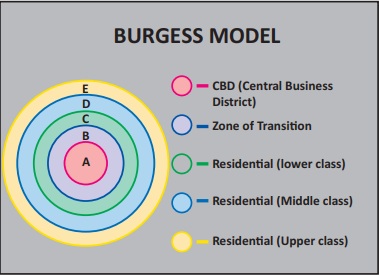Human Settlements | Geography - The concentric zone theory | 12th Geography : Chapter 2 : Human Settlements
Chapter: 12th Geography : Chapter 2 : Human Settlements
The concentric zone theory
The concentric zone theory
This theory was given by Ernest Burgess
in 1925. He envisaged that the development of a city outwards from a centre in concentric
zones in a ripple-like fashion. He made the following assumptions:

A. The city grows outwards in the form
of five concentric zones or rings as long as there are no physical barriers, such
as rivers or hills to distort the pattern.
B. The city has a single centre.
C. Growth is accomplished by a simple
extension of each zone outwards into the next zone.
The characteristic features of each of
the five zones can be described as follows.
Zone A: The central business district (C.B.D)
It is the heart of the urban community
where the commercial, social and civic activities are concentrated. The heart of
the C.B.D. or the downtown core has office buildings, departmental stores, theatres,
hotels, banks and civic government buildings, while outside this core are warehouses
and light industry.
Zone B: The transition zone next to the C.B.D
It is the transition zone where the central
business activities and factories mix and invade an area of aging residential dwellings.
This is also the zone of residential decay where the new migrants come and live
because the rents are low and transportation costs to the workplace are minimal.
Thus, these are the sites of urban slums.
Zone C: The zone of independent working men’s home
This zone is inhabited by the blue-collar
workers who are generally the second generation migrants. These people have the
capacity to own their individual houses away from the C.B.D., but still live within
easy access of their workplace. Here, the family groups are more stable and crime
rates are lower.
Zone D: The zone of better residence
The next concentric zone has middle and
upper class residences which are approximately 15 to 20 minutes by public transport
from zone 1.
Zone E: The commuter zone
This outer zone encircles the city and
lies beyond the continuous built-up areas. Much of this zone is still an open space
and is often located beyond the city limits. Here, small villages, surrounded by
open country, gradually become suburbs. Since people in this zone work in the C.B.D.,
the commuter zone is located within one hour’s travelling time from the centre of
the city.
Burgess stressed that the outward growth
of the city implies that each zone is not static. Business activities expand into
the transition zone which forces low income groups to move outwards. This group,
then, displaces the middle class and the wealthy that, in turn, are forced to move
outwards.
Related Topics